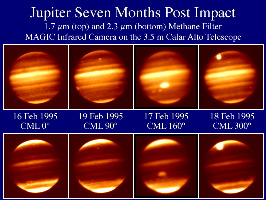

NOTE: Click on the image to view it at its highest resolution.
These images show Jupiter seven months after the fragments of Comet Shoemaker-Levy 9 struck the planet in July of 1994. The individual impact sites have now spread into a continuous band encircling Jupiter's southern mid-latitudes. Taken over a four day span in mid-February, these frames cover a full planetary rotation and show significant variations in the width and intensity of the impact residue. The observing date and approximate central meridian longitude appears between each pair of images taken at 1.7 microns (top row) and 2.3 microns (bottom row). Absorption due to methane in Jupiter's atmosphere darkens the underlying cloud deck at these wavelengths, thereby maximizing the contrast of the impact structures. The largest Galilean moon, Ganymede, is transiting across Jupiter in the rightmost images.
Images taken at approximately 6:00 UT on 17, 18, 19, and 20 February 1995 (On the image, February 16 refers to the night of the 16-17th)
MAGIC Infrared Camera (256x256 HgCdTe Detector); 1.7 um and 2.3 um CH4 absorption filters
3.5 m f/10 Calar Alto Telescope; 0.32 arcseconds / pixel
Picture Credit: Tom Herbst (Max-Planck-Institut fuer Astronomie)
Contact People:
Tom Herbst, Max-Planck-Institut fuer Astronomie, Heidelberg
Doug Hamilton, Max-Planck-Institut fuer Kernphysik, Heidelberg